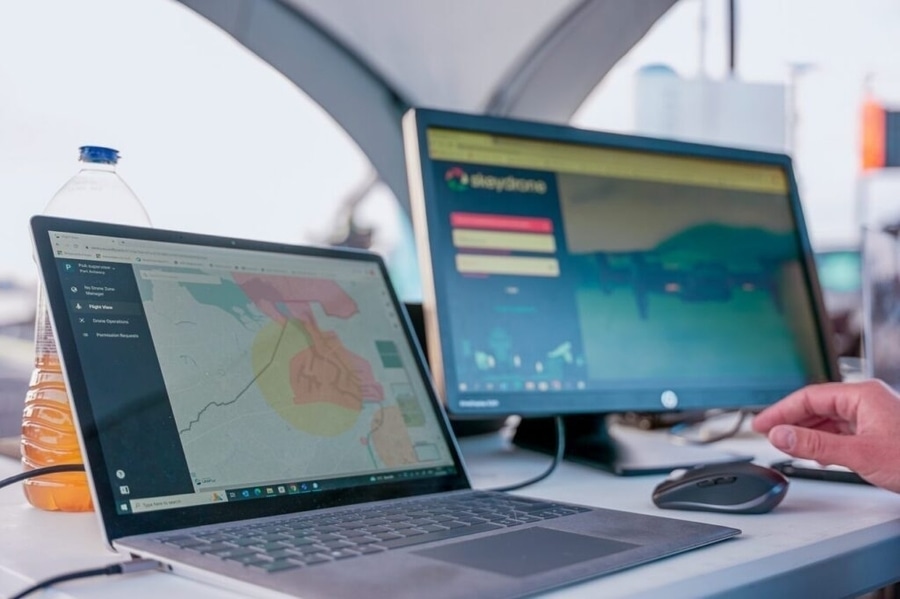
#Industry News
Unmanned Traffic Management in 2023: Insights from the CEO of Unifly
Unifly, an unmanned traffic management (UTM) system provider, has developed a platform for managing the integration of drones and other advanced types of aircraft into low-altitude airspace.
Avionics International covered some updates from the company in a recent issue of our magazine. We spoke with Unifly’s co-founder and CEO, Andres Van Swalm, last May following the news of a €10 million investment from Terra Drone Corporation and Japanese government fund JOIN. Unifly has partnered with ENAIRE, a Spanish ANSP, to develop an automated digital drone management platform. The UTM system provider also launched a UTM platform in collaboration with the Port of Antwerp.
Avionics recently interviewed Van Swalm again to learn about what Unifly has planned for 2023. He noted that the enforcement of U-space (the European equivalent of UTM) regulations starts this year, and their UTM system can be configured to be U-space compliant. However, it is not designed to only be U-space compliant. For example, Unifly’s RPAS Traffic Management (RTM) platform is used by the ANSP in Canada and complies with regulations there.
Van Swalm believes that 2023 will be when the drone industry truly takes off, and that UTM as well as U-space will play crucial roles in enabling the industry to scale. This year, Unifly plans to launch one of the first implementations of U-space in Spain in partnership with Indra and ENAIRE. This is one of the major objectives for the company in 2023.
In addition to working with Indra and ENAIRE, Unifly is also working with the Bulgarian Air Traffic Services Authority (BULATSA) and SkeyDrone, a subsidiary of the Belgian air traffic controller for manned flights. Additionally, Van Swalm shared that they are in talks with DFS (Deutsche Flugsicherung), the German ANSP. These will be the main focuses for Unifly in Europe in the near-term.
NAV CANADA, the ANSP of Canada, entered into an agreement with Unifly to deploy a fully digitized system for operating and managing drones. For drone pilots, the system makes the authorization request process both easier and faster. It can support current regulations for drones operating within visual line of sight.
Van Swalm remarked in the interview with Avionics, “Together with Nav Canada, we will look at how we can promote the UTM system even more. We will also launch a set of new features and functionalities for more extensive use of the UTM system and enabling more complex drone operations in Canada.”
He also drew attention to the fact that Unifly went live in NEOM—a smart city in Saudi Arabia currently in development. “They are very ambitious and want to start flying eVTOLs [electric vertical take-off and landing aircraft] as soon as possible, especially Volocopter.”
Unifly’s UTM platform will be used in NEOM, and the team will launch a new set of features there “to enable very complex eVTOL and drone operations.”
One current objective for the UTM system provider is to offer better support for automated operations that are conducted beyond visual line of sight (BVLOS). Their system makes advanced flight planning for BVLOS operations much easier.
“We are continuing to build on our API,” said Van Swalm. “Unifly is there to enable autonomous aviation. It’s not just using our user interface. We’re working on user-friendly APIs where systems like Volocopter or drone operators can connect using an API—they don’t need to use our interface.”
Unifly hopes to offer its customers a higher degree of configurability in the coming year so that they are able to configure the system by themselves if they wish. Their customers have specifically requested this increased configurability, Van Swalm explained. “We will continue to build more advanced U-space functionalities, such as tactical deconfliction,” he noted.
According to Unifly’s CEO, there are two main challenges facing the drone industry. The first is standardization of UTM and U-space. “It’s quite API-driven; it requires connections, and it can only work if we standardize,” he explained. “There are a lot of standardization initiatives, but some standards need to be defined from scratch. To enable communication with each other, we need to work on standardization.”
The second obstacle is the need to develop the optimal business model for drones. Drone operators have small margins, and it is not yet clear what the best business model will be.
“We’re a technology company,” Van Swalm commented. “It’s more a challenge for our customers, but it’s also a challenge for us. Our customers need to know how they are going to earn money if they are going to provide the service.
“We are looking into how we can create a sustainable business model, and what are good prices for drone operators to pay,” he added.

